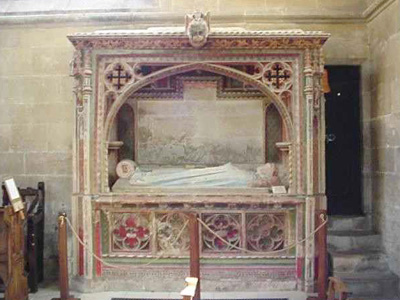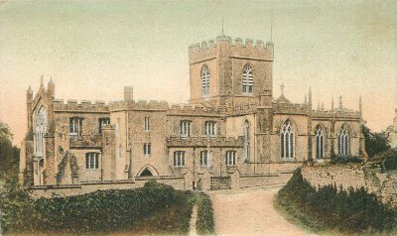
|
In 1352 the first stone of the new Priory at Edington was laid. When completed, the Bishop, at the suggestion it is said of the Black Prince, created an order of "The Rector and Brothers of Edington". They were of the Order of St. Augustine, but a particular class called "Boni Homines" or "Bonhommes". There was, at the time, only one religious house of the order in England at Ashridge in Bucks – Edington became the second and there were never any others. In the Royal Charter of Confirmation it is described as dedicated to St. Mary. St. Katherine and All Saints. This wonderful church of St. Mary The Virgin, St. Katherine and All Saints, Edington, looks like a fortified mansion and there is an excellent guide to the church written by Ken Rogers (who was Wiltshire's County Archivist), and it has a useful section on the Baynton Monument, much of which is reproduced above. At the end of the south transept of the church there is a large altar tomb monument of an ecclesiastic of evident dignity, believed to be a Bonhomme who reposes under a magnificent canopy, the upper part of which is formed by two quatrefoils. It is referred to as the Baynton monument. This fine example of craftsmanship is thought to be of the late 15th century (c1420-25) with extremely rare original colouring and is an outstanding feature of the church.
There is also a single rebus in the middle of the frieze which differs slightly from the others – again a sprig growing out of some kind of animal, partly defaced over the centuries. The supporting pillars of the monument have niches carrying the figures of St. Peter and St. Paul, holding their symbols of keys and sword respectively. Directly behind it is the bare wall of the church, where a panel of stone or brass may have at once been insetted. Since the centre part is raised, this panel may have represented the crucifixion, but like so many of the church's fine brasses, this may have been removed in the 16th century. Today you can see the marks on the stone floor as proof of how many of the monumental brasses have been stolen and dragged along the ground over the centuries. The effigy, in long robes, is also badly defaced with his head resting on a cushion and his feet resting against the tun (barrel) with the initials I.B. upon it and further monograms of W and XB. The letter "I" was the Roman equivalent of "J". During the Classical period, the Latin alphabet consisted of only 23 letters – without the letters j, v and w. There is a vault inside the tomb. Beneath the effigy, the front of the tomb is divided into four panels – two containing a rebus and two with the Tudor Rose. Graham Laslett has researched the Priory and the monument itself and has put forward many interesting suggestions as to who the mysterious J.B. was. The identity of who it represents has never been certainly established. Who is it? Who is the lordly monk or mitred abbot who there reposes? The architecture and style speak of a later date than the time of William of Edington. There are suggestions that perhaps the monument relates to a John from the town of Baynton, but the description of rebus and barrel (as in a sprig of "bay" and a barrel "tun") is that of the Bayntun/Baynton coat of arms, which applies to a person or family and not a place. This may further indicate that the monument could indeed be associated with the Bayntun family. Nikolaus Pevsner describes the monument as a Bonhomme tomb with the initials I.B. and the name ending in tun (see the tun as a rebus). Hence the connection to the family of Bayntun (or Baynton as it was also spelt in medieval times). John Aubrey believed the tomb to be of a John Bayntun – but there is no known member of the Priory who bore that name. The Edington Church Guide believed the tomb to be of a Thomas Baynton. If you take the branch to be a beck, which is an old word expressing a twig, then look at its insertion in the ton or barrell – we can piece together the word Beckinton. As the most ordinary mode of describing a monk or friar in those days would be the conjunction of his christian name and place of abode, and as the village of Beckington is near enough to have probably supplied recruits to the neighbouring Monastery of Edington, could it not be that John of Beckington is the name of the monk who slumbers in death beneath. Leyland refers to a John Bloebury (or John de Blebery), a brother, as benefactor with the chantry. This is another candidate with the initials J.B. The monument was restored and re-coloured in 1969-70 and traces of this colour were thought to be observable but a later and detailed examination revealed no underlying colour so the original appearance of the robe actually remains a matter for speculation, but the upper part of the monument retains much of its original colour. It had always been understood that the body of the monk was buried beneath the tomb but an excavation in 1988 revealed an arched vault partially under the tomb which had been disturbed in the 17th century and the body removed. Another theory is that the vault (which pre-dated the monument) never contained a body.
Upon his execution in 1549, all these were granted to Sir William Pawlett, the Earl of Wiltshire, and first Marquis of Winchester. During the ownership by the Pawlett family, the Priory was leased, in 1551, to Sir Edward Hastings and Lady Isabel Bayntun – the widow of Sir Edward Bayntun, who died in 1545. She obtained a lease from the Crown of the site and demesnes of the dissolved Monastery for 41 years where she was apparently living in 1554. She must have been a tenant at Edington under Pawlett by a second grant from the Crown after the attainer and execution of Lord Seymour. In 1565 the lease belonged to Sir James Stump of Malmesbury, who at the time, was married to Lady Isabel. Less than a mile to the east of the Priory there are two farms – Upper Baynton Farm and Lower Baynton Farm which may indicate the Baynton's being a local family. But there is also a mention of a Manor of Baynton in Edington parish, which was given by John Rous in 1442. The monastery at Edington was well endowed and this Sir John Rous, of Imber, allotted Baynton Manor to it in 1449. Could this be the "John of Bayntun" who was buried there? I am grateful to Graham Laslett CBE for a copy of his lecture given in front of the monument in 2001 and his superb drawing of the angel (pictured above). Please email businesscards@iinet.net.au if you can help us solve this mystery, or if you have any additional information you wish to contribute or should you consider anything above to be incorrect. |


